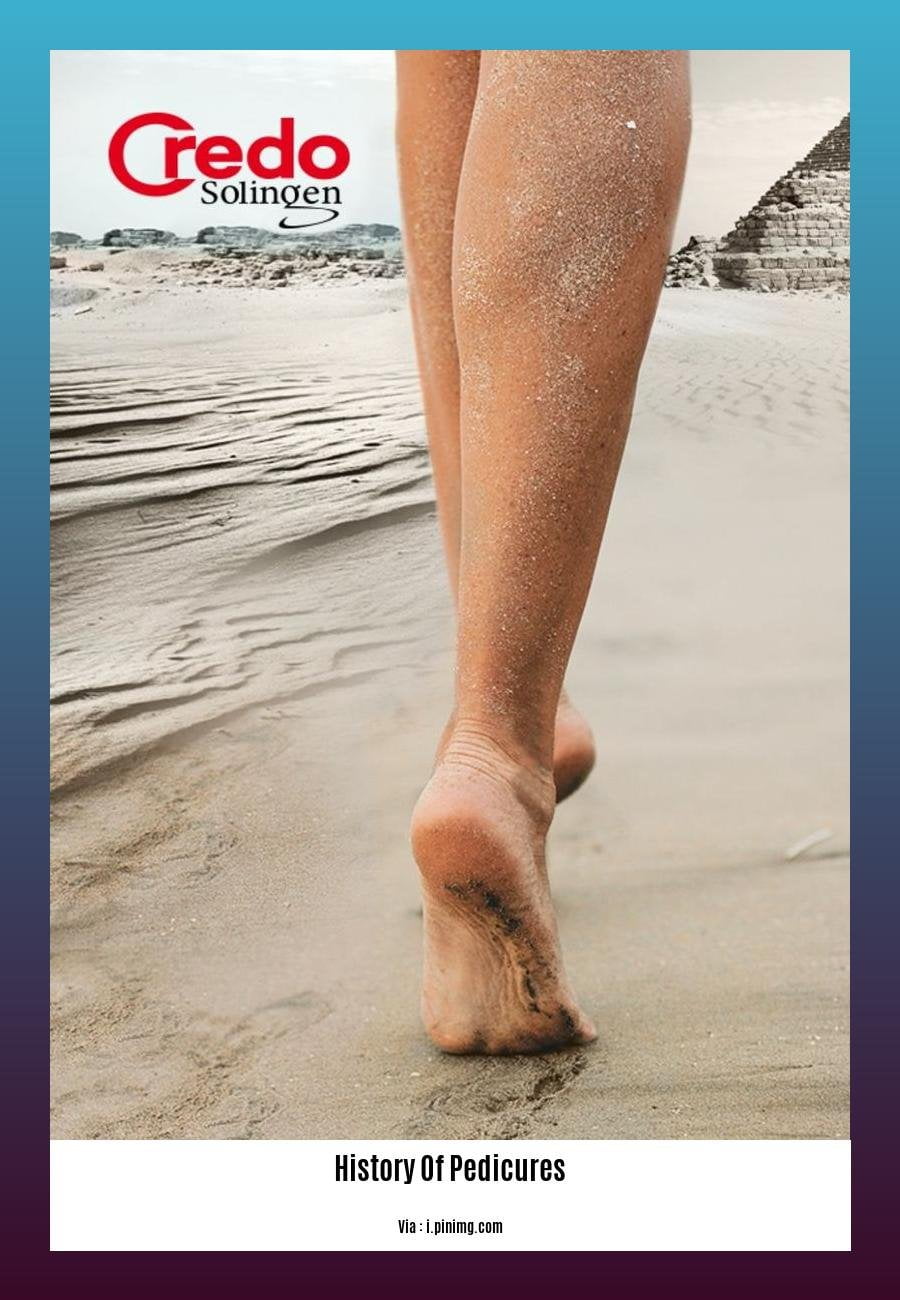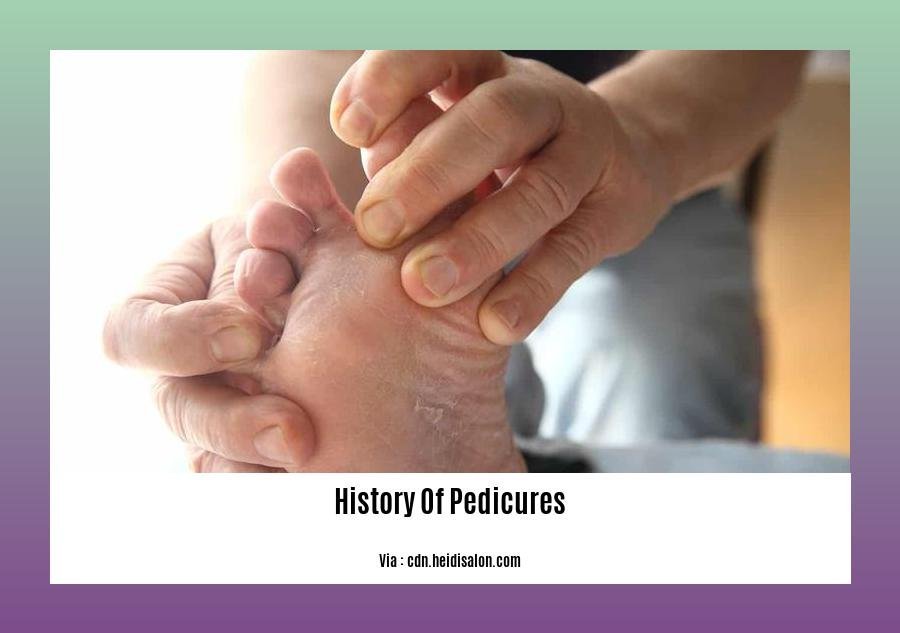Embark on a captivating journey through time as we delve into the rich history of pedicures. From the gilded chambers of ancient Egypt to the vibrant salons of today, discover how this ubiquitous beauty treatment has evolved over the centuries, reflecting cultural traditions, fashion trends, and the ever-changing pursuit of self-care. In this exploration of A Journey Through Time: Unveiling the Rich History of Pedicures, we’ll uncover the fascinating stories behind this timeless ritual and its enduring appeal.
Key Takeaways:
- Pedicures have a long history, dating back to ancient times.
- Ancient Egyptians practiced pedicures as early as the sixth century BCE.
- Pedicures were initially used to treat medical foot conditions.
- The term “pedicure” comes from the Latin words pedis (“of the foot”) and cura (“care”).
- Pedicures were only introduced to North America in the early 20th century.
History of Pedicures

Pedicures have captured the attention of cultures across the globe for centuries. Let’s take a stroll through time and uncover the fascinating history of pedicures.
Ancient Foot Care Rituals
Imagine ancient Egyptians applying intricate henna designs to their feet, as far back as the sixth century BCE. Foot pedicures were not just about beauty; they were believed to have therapeutic benefits. In ancient Rome, wealthy citizens frequented public baths to indulge in pedicures and massages.
Pedicures Arrive in North America
The early 20th century marked the introduction of pedicures to North America. Though initially associated with luxury and leisure, pedicures gained popularity with the rise of the movie industry in Hollywood during the 1930s as movie stars began flaunting their well-groomed feet.
The Modern Pedicure Industry
With increasing awareness of personal care, the pedicure industry experienced a boom in the 1960s. Nail polish colors proliferated, and advancements in tools and techniques transformed pedicures into the comprehensive foot care we know today.
Foot Care Through the Decades
| Era | Focus | Notable Developments |
|---|---|---|
| Ancient Egypt | Holistic Well-being | Henna Designs, Foot Massages |
| Roman Empire | Social Status | Public Baths, Pedicures for the Elite |
| Early 20th Century | Luxury & Leisure | Introduction to North America |
| 1930s-1940s | Movie Glamour | Celebrities Influencing the Trend |
| 1960s | Personal Care Revolution | Boom in the Pedicure Industry |
| Modern Day | Comprehensive Foot Care | Advanced Techniques, Color Variety |
Pedicures Today
In the modern era, pedicures have evolved into a form of self-care and pampering. They’re not just about aesthetics but also about maintaining healthy feet. Pedicure services have expanded, including treatments like exfoliation, callus removal, and intricate nail art.
Conclusion
From ancient rituals to modern-day practices, the history of pedicures is a testament to the enduring importance of foot care. Pedicures continue to evolve, reflecting our evolving attitudes towards beauty, wellness, and self-care.
Ever wondered how the humble paper bag came to be? Dive into the intriguing history of paper bags and discover the fascinating journey of this everyday item that has played a significant role in our lives. history of paper bags
Parchment paper, a ubiquitous material with a rich past, has played a pivotal role in shaping the course of human history. Embark on a captivating exploration of the history of parchment paper and uncover the secrets of its remarkable endurance. history of parchment paper
From the ancient rhythms of tribal gatherings to the mesmerizing beats of modern-day music, percussion instruments have left an indelible mark on human culture. Delve into the captivating history of percussion instruments and witness the evolution of these powerful sound-makers that have captivated hearts and souls across the ages. history of percussion instruments
Cultural Influences: Examining how cultural norms and traditions influenced pedicure practices across different regions, from Asia to Europe.
As we embark on a journey through the history of pedicures, we cannot overlook the profound impact of cultural norms and traditions on shaping this ubiquitous beauty practice. Across different regions, from Asia to Europe, pedicures have evolved, influenced by unique cultural perspectives on beauty, health, and well-being.
Asia
In China, pedicures date back to the Tang Dynasty (618-907 AD). They were not just about aesthetics but also held medicinal and therapeutic significance, with foot reflexology believed to promote overall health.
In Japan, pedicures have traditionally been associated with cleanliness. Geishas underwent elaborate foot care rituals, soaking their feet in warm water infused with fragrant flowers to soften the skin and enhance their allure.
In India, pedicures have a strong connection to Ayurvedic practices. Applying henna to the feet is a common custom, believed to cool the body, improve circulation, and bring good luck.
Europe
In ancient Greece, pedicures were seen as a symbol of wealth and status. Women of means indulged in foot baths with scented oils and pumice stones to maintain soft, smooth feet.
In Rome, pedicures were an essential part of the elaborate bathing rituals in public baths. Skilled pedicurists used specialized tools to trim nails, remove calluses, and apply aromatic oils to soften the skin.
In the Middle Ages, pedicures were largely neglected due to the influence of the Church, which deemed them vain and excessive. However, the Renaissance saw a revival of interest in foot care, with pedicures becoming popular among the upper classes.
Modern Influences
In the 20th century, pedicures became more accessible and widespread, thanks to the rise of mass media and the beauty industry.
Hollywood actresses and models popularized pedicures, making them a symbol of glamour and sophistication.
Today, pedicures have evolved into a global phenomenon, with cultural influences continuing to shape their practice. From traditional Asian foot reflexology to modern European spa treatments, pedicures reflect the diverse cultural tapestry of our world.
Key Takeaways:
Cultural norms and traditions have significantly influenced pedicure practices across different regions.
In Asia, pedicures have medicinal and therapeutic significance, while in Europe, they have historically been associated with wealth and status.
The rise of mass media and the beauty industry in the 20th century made pedicures more accessible and popular worldwide.
Pedicures have evolved into a global phenomenon, with cultural influences continuing to shape their practice.
References:
[1]
[2]
Rise of the Modern Pedicure Industry: Highlighting the emergence of the modern pedicure industry, driven by factors such as changing fashion trends and the pursuit of personal grooming.

The rise of the modern pedicure industry is a testament to the ever-changing landscape of fashion, beauty, and self-care. In the past few decades, pedicures have evolved from a simple foot treatment to a full-blown pampering experience, driven by factors such as:
Key Takeaways:
- The global nail salon market is projected to grow at a CAGR of over 7.5% from 2023 to 2032, driven by factors such as increasing demand for innovative nail care services, rising disposable incomes, and growing awareness of personal grooming.
The pedicure sector is witnessing trends such as the rise of medical pedicures, increased demand for natural and organic products, and growing popularity of home-based pedicure services.
Changing Fashion Trends:
- The rise of open-toe footwear and sandals has put a spotlight on our feet, making pedicures a must-have for fashion-forward individuals.
The popularity of intricate nail art and embellishments has further fueled the demand for professional pedicures.
Pursuit of Personal Grooming:
- The growing emphasis on self-care and personal grooming has led to an increased demand for pedicures as a way to pamper and rejuvenate.
Pedicures are no longer just a luxury but have become an essential part of a well-rounded grooming routine.
Technological Advancements:
- The development of new tools and techniques, such as electric foot files and gel polishes, has made pedicures more efficient, effective, and long-lasting.
These advancements have contributed to the popularity of pedicures by making them more accessible and appealing to a wider range of consumers.
Celebrity Influence:
- The rise of celebrity culture has played a significant role in popularizing pedicures.
- Celebrities are often seen sporting perfectly polished toenails, which has influenced fashion trends and consumer behavior.
The modern pedicure industry has witnessed significant growth in recent years, with nail salons and spas offering a wide range of services to cater to the diverse needs of customers. From basic pedicures to more elaborate spa treatments, there’s a pedicure option to suit every taste and budget.
The Future of the Pedicure Industry:
– As the demand for pedicures continues to grow, we can expect to see even more innovation and advancements in the industry.
– The use of technology, such as smart nail care devices and virtual reality experiences, is likely to play a role in shaping the future of pedicures.
– The industry is also expected to see a growing focus on sustainability, with consumers increasingly demanding eco-friendly and ethical products and services.
Citations:
- Trending in the Pedicure Sector | Coursle
- Nail Salon Market Size Worth $16.3 Billion By 2032 | CAGR: 7.5% – Grand View Research, Inc.
Contemporary Trends: Discussing current trends and innovations in the pedicure industry, including advancements in nail art, foot care technologies, and the growing emphasis on holistic wellness.
In the ever-evolving landscape of beauty and wellness, pedicures have undergone a remarkable transformation, reflecting the dynamic shifts in societal norms and technological advancements. Today, pedicures transcend mere aesthetics, embracing holistic approaches to foot care and fostering a sense of personal well-being. Let’s delve into the contemporary trends reshaping the pedicure industry:
1. Nail Art Revolution:
In the realm of nail art, creativity reigns supreme. From intricate designs and eye-catching patterns to 3D embellishments and vibrant hues, nail artists are pushing the boundaries of artistic expression. This explosion of creativity has given rise to nail art as a form of self-expression, allowing individuals to showcase their unique style and personality through their pedicures.
2. Technological Advancements:
Innovation is at the forefront of the pedicure industry, with an array of technological advancements revolutionizing foot care practices. Electronic foot files, for instance, offer precise and efficient callus removal, while LED curing lamps expedite the drying process of gel polishes, ensuring long-lasting results. These technological innovations enhance the overall pedicure experience, ensuring both efficiency and effectiveness.
3. Holistic Wellness:
The modern pedicure has evolved into a holistic self-care ritual that extends beyond aesthetics to encompass foot health and overall well-being. Pedicures now often incorporate therapeutic elements such as reflexology massage, hot stone therapy, and essential oils, promoting relaxation, stress reduction, and improved circulation. This holistic approach to foot care reflects the growing emphasis on self-care and the pursuit of total body wellness.
4. Home-Based Pedicures:
The convenience and comfort of home-based pedicures have gained significant traction in recent times. DIY pedicure kits, complete with essential tools and high-quality polishes, empower individuals to pamper their feet in the comfort of their own homes. This trend aligns with the growing demand for personalized self-care routines and the desire for greater control over the pedicure experience.
Key Takeaways:
- Pedicures have evolved into a form of self-expression and artistic creativity, with nail art emerging as a popular trend.
- Technological advancements, such as electronic foot files and LED curing lamps, enhance the efficiency and effectiveness of pedicure treatments.
- The modern pedicure embraces a holistic approach, incorporating therapeutic elements like massage, hot stone therapy, and essential oils for relaxation and improved well-being.
- The growing popularity of home-based pedicures reflects the desire for convenience, comfort, and personalized self-care routines.
Sources:
[1]
[2]
FAQ
Q1: How did ancient Egyptians treat foot conditions before the introduction of pedicures?
A1: Although there is no direct evidence of pedicures in ancient Egypt specifically for treating foot conditions, historical records suggest that foot care practices existed. Pedicures were likely combined with other foot care rituals, such as bathing and massaging the feet, to maintain overall foot health and prevent discomfort.
Q2: Why were pedicures introduced to North America in the early twentieth century?
A2: Pedicures were introduced to North America in the early twentieth century due to the influence of European beauty trends and a growing emphasis on personal hygiene and grooming. As North American society became more affluent, there was an increased demand for services that promoted personal appearance and well-being, including pedicures.
Q3: How has the pedicure industry evolved in recent years?
A3: The pedicure industry has experienced significant growth in recent years, driven by factors such as rising disposable incomes, increasing demand for self-care and wellness services, and the popularity of nail art and intricate designs. The industry has also seen the emergence of new trends, such as medical pedicures and the use of organic and natural products, reflecting a growing emphasis on foot health and holistic well-being.
Q4: What are some of the cultural influences that have shaped the evolution of pedicures?
A4: Pedicures have been influenced by cultural factors throughout history. In ancient Egypt, pedicures were associated with religious rituals and beauty practices. In ancient Rome, pedicures were seen as a symbol of luxury and indulgence. In modern times, pedicures have become a global trend, influenced by fashion and beauty standards from various cultures, such as Japanese foot spas and Brazilian pedicures.
Q5: What does the future hold for the pedicure industry?
A5: The future of the pedicure industry is expected to witness continued growth and innovation. Technological advancements, such as smart foot spas and automated nail care systems, may enhance the pedicure experience and improve efficiency. Additionally, the growing emphasis on health and wellness may lead to the integration of therapeutic and medical pedicures, focusing on foot health, pain relief, and overall well-being.















